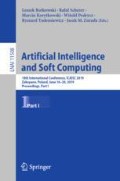Abstract
Bayesian Networks (BN) are used for representing and inferring over variables with aleatory uncertainty. Dynamic Bayesian Networks (DBN) extend this concept by introducing temporal dependencies that catch dynamic behaviors from the domain variables. Effective and efficient modeling through BN demands data discretization on categories. However, these categories may have vagueness uncertainty, once are used labels not defined by exact numerical thresholds. Fuzzy Theory provides a framework for modeling vagueness uncertainty. Although hybrid theories to integrate Fuzzy Theory and BN inference process have been proposed, there are still limitations on using fuzzy evidence on DBN. The related works restrict the evidence modeling to the overlapping of only two fuzzy membership functions. Thereby, this work proposes a method for Dynamic Fuzzy-Bayesian inference over non-dichotomic variables. To evaluate the proposal, the model is applied as a classifier on the Detection Occupancy Dataset and compared with other approaches. In the experiments, the model obtained Accuracy 97% and Recall 92%.
This study was financed by the Coordination for the Improvement of Higher Education Personnel - Brazil (CAPES) - Finance Code 001. Munyque Mitttelmann acknowledges the support of the ANR project AGAGE ANR-18-CE23-0013.
Access this chapter
Tax calculation will be finalised at checkout
Purchases are for personal use only
Notes
- 1.
A dichotomic variable can be split only in two states.
References
Brignoli, J.T., Pires, M.M., Nassar, S.M., Sell, D.: A fuzzy-Bayesian model based on the superposition of states applied to the clinical reasoning support. In: IntelliSys 2015 - Proceedings of 2015 SAI Intelligent Systems Conference, pp. 210–219 (2015)
Candanedo, L.M., Feldheim, V.: Accurate occupancy detection of an office room from light, temperature, humidity and CO2 measurements using statistical learning models. Energy Build. 112, 28–39 (2016)
Dawid, A.P.: Conditional independence in statistical theory. J. R. Stat. Soc. Ser. B (Methodol.) 41(1), 1–31 (1979)
Dempster, A.P., Laird, N.M., Rubin, D.B.: Maximum likelihood from incomplete data via the EM algorithm. J. R. Stat. Soc. Ser. B (Methodol.) 39(1), 1–38 (1977)
Dheeru, D., Karra Taniskidou, E.: (UCI) Machine Learning Repository (2017). http://archive.ics.uci.edu/ml
Di Tomaso, E., Baldwin, J.F.: An approach to hybrid probabilistic models. Int. J. Approx. Reason. 47(2), 202–218 (2008)
Feng, Y., Jia, Q., Chu, M., Wei, W.: Engagement evaluation for autism intervention by robots based on dynamic Bayesian network and expert elicitation. IEEE Access 5, 19494–19504 (2017)
Khalid, A.J., Wang, J., Nurudeen, M.: A new fault classification model for prognosis and diagnosis in CNC machine. In: 2013 25th Chinese Control and Decision Conference, CCDC 2013, pp. 3538–3543 (2013)
Kolmogorov, A.N.: Foundations of the Theory of Probability (1956)
Li, Y., Chen, J., Feng, L.: Dealing with uncertainty: a survey of theories and practices. IEEE Trans. Knowl. Data Eng. 25, 2463–2482 (2013)
Li, J., Gao, X.: Fuzzy variable structure dynamic Bayesian network applying target recognition. In: 2016 First IEEE International Conference on Computer Communication and the Internet (ICCCI), pp. 434–438 (2016)
Mihajlovic, V., Petkovic, M.: Dynamic Bayesian networks: a state of the art. CTIT Tech. Rep. Ser. 34, 1–37 (2001)
Murphy, K.P.: Dynamic Bayesian networks: representation, inference and learning. Ph.D. thesis, University Of California, Berkeley (2002)
Naderpour, M., Lu, J., Zhang, G.: A fuzzy dynamic Bayesian network-based situation assessment approach. In: 2013 IEEE International Conference on Fuzzy Systems (FUZZ-IEEE), pp. 1–8 (2013)
Naderpour, M., Lu, J., Zhang, G.: An intelligent situation awareness support system for safety-critical environments. Decis. Support. Syst. 59(1), 325–340 (2014)
Nojavan, F.A., Qian, S.S., Stow, C.A.: Comparative analysis of discretization methods in Bayesian networks. Environ. Model. Softw. 87, 64–71 (2017)
Sykes, E.R.: Preliminary findings of visualization of the interruptible moment. In: Mewhort, D.J.K., Cann, N.M., Slater, G.W., Naughton, T.J. (eds.) HPCS 2009. LNCS, vol. 5976, pp. 215–229. Springer, Heidelberg (2010). https://doi.org/10.1007/978-3-642-12659-8_16
Teixeira, M.A., Zaverucha, G.: A partitioning method for fuzzy probabilistic predictors. In: Neural Information Processing, pp. 929–934 (2004)
Yao, J.Y., Li, J., Li, H., Wang, X.: Modeling system based on fuzzy dynamic bayesian network for fault diagnosis and reliability prediction (2015)
Zhang, H., Li, R.: Emotional nonverbal communication based on fuzzy dynamic Bayesian network. In: 9th International Conference on Control, Automation, Robotics and Vision, ICARCV 2006 (2006)
Author information
Authors and Affiliations
Corresponding author
Editor information
Editors and Affiliations
Rights and permissions
Copyright information
© 2019 Springer Nature Switzerland AG
About this paper
Cite this paper
Mittelmann, M., Marchi, J., von Wangenheim, A. (2019). A Fuzzy-Dynamic Bayesian Network Approach for Inference Filtering. In: Rutkowski, L., Scherer, R., Korytkowski, M., Pedrycz, W., Tadeusiewicz, R., Zurada, J. (eds) Artificial Intelligence and Soft Computing. ICAISC 2019. Lecture Notes in Computer Science(), vol 11508. Springer, Cham. https://doi.org/10.1007/978-3-030-20912-4_30
Download citation
DOI: https://doi.org/10.1007/978-3-030-20912-4_30
Published:
Publisher Name: Springer, Cham
Print ISBN: 978-3-030-20911-7
Online ISBN: 978-3-030-20912-4
eBook Packages: Computer ScienceComputer Science (R0)

